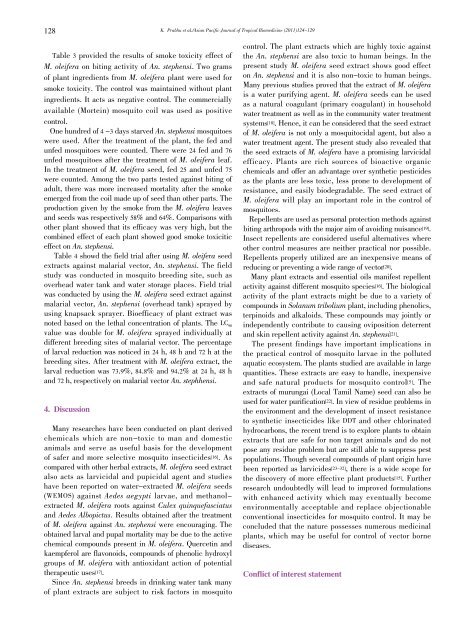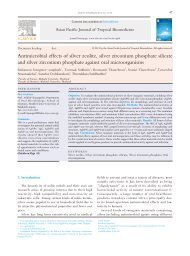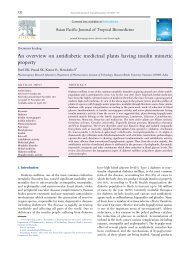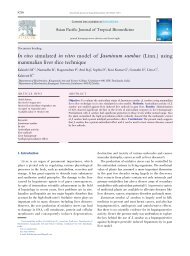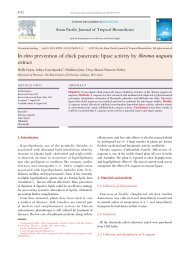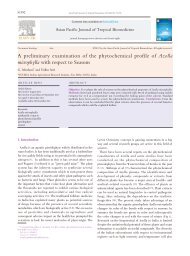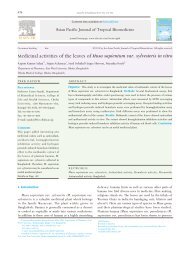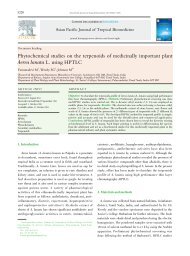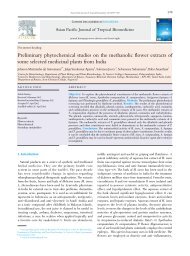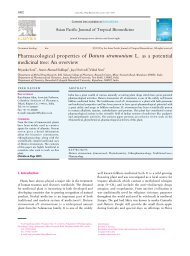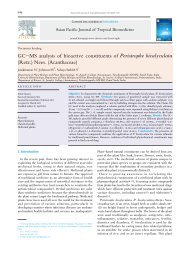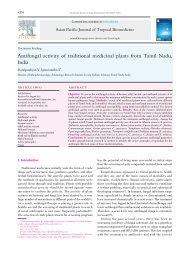Larvicidal and repellent potential of Moringa oleifera ... - Apjtb.com
Larvicidal and repellent potential of Moringa oleifera ... - Apjtb.com
Larvicidal and repellent potential of Moringa oleifera ... - Apjtb.com
You also want an ePaper? Increase the reach of your titles
YUMPU automatically turns print PDFs into web optimized ePapers that Google loves.
128<br />
Table 3 provided the results <strong>of</strong> smoke toxicity effect <strong>of</strong><br />
M. <strong>oleifera</strong> on biting activity <strong>of</strong> An. stephensi. Two grams<br />
<strong>of</strong> plant ingredients from M. <strong>oleifera</strong> plant were used for<br />
smoke toxicity. The control was maintained without plant<br />
ingredients. It acts as negative control. The <strong>com</strong>mercially<br />
available (Mortein) mosquito coil was used as positive<br />
control.<br />
One hundred <strong>of</strong> 4 -3 days starved An. stephensi mosquitoes<br />
were used. After the treatment <strong>of</strong> the plant, the fed <strong>and</strong><br />
unfed mosquitoes were counted. There were 24 fed <strong>and</strong> 76<br />
unfed mosquitoes after the treatment <strong>of</strong> M. <strong>oleifera</strong> leaf.<br />
In the treatment <strong>of</strong> M. <strong>oleifera</strong> seed, fed 25 <strong>and</strong> unfed 75<br />
were counted. Among the two parts tested against biting <strong>of</strong><br />
adult, there was more increased mortality after the smoke<br />
emerged from the coil made up <strong>of</strong> seed than other parts. The<br />
production given by the smoke from the M. <strong>oleifera</strong> leaves<br />
<strong>and</strong> seeds was respectively 58% <strong>and</strong> 64%. Comparisons with<br />
other plant showed that its efficacy was very high, but the<br />
<strong>com</strong>bined effect <strong>of</strong> each plant showed good smoke toxicitic<br />
effect on An. stephensi.<br />
Table 4 showd the field trial after using M. <strong>oleifera</strong> seed<br />
extracts against malarial vector, An. stephensi. The field<br />
study was conducted in mosquito breeding site, such as<br />
overhead water tank <strong>and</strong> water storage places. Field trial<br />
was conducted by using the M. <strong>oleifera</strong> seed extract against<br />
malarial vector, An. stephensi (overhead tank) sprayed by<br />
using knapsack sprayer. Bioefficacy <strong>of</strong> plant extract was<br />
noted based on the lethal concentration <strong>of</strong> plants. The LC 90<br />
value was double for M. <strong>oleifera</strong> sprayed individually at<br />
different breeding sites <strong>of</strong> malarial vector. The percentage<br />
<strong>of</strong> larval reduction was noticed in 24 h, 48 h <strong>and</strong> 72 h at the<br />
breeding sites. After treatment with M. <strong>oleifera</strong> extract, the<br />
larval reduction was 73.9%, 84.8% <strong>and</strong> 94.2% at 24 h, 48 h<br />
<strong>and</strong> 72 h, respectively on malarial vector An. stephhensi.<br />
4. Discussion<br />
Many researches have been conducted on plant derived<br />
chemicals which are non-toxic to man <strong>and</strong> domestic<br />
animals <strong>and</strong> serve as useful basis for the development<br />
<strong>of</strong> safer <strong>and</strong> more selective mosquito insecticides [16]. As<br />
<strong>com</strong>pared with other herbal extracts, M. <strong>oleifera</strong> seed extract<br />
also acts as larvicidal <strong>and</strong> pupicidal agent <strong>and</strong> studies<br />
have been reported on water-extracted M. <strong>oleifera</strong> seeds<br />
(WEMOS) against Aedes aegypti larvae, <strong>and</strong> methanolextracted<br />
M. <strong>oleifera</strong> roots against Culex quinquefasciatus<br />
<strong>and</strong> Aedes Albopictus. Results obtained after the treatment<br />
<strong>of</strong> M. <strong>oleifera</strong> against An. stephensi were encouraging. The<br />
obtained larval <strong>and</strong> pupal mortality may be due to the active<br />
chemical <strong>com</strong>pounds present in M. <strong>oleifera</strong>. Quercetin <strong>and</strong><br />
kaempferol are flavonoids, <strong>com</strong>pounds <strong>of</strong> phenolic hydroxyl<br />
groups <strong>of</strong> M. <strong>oleifera</strong> with antioxidant action <strong>of</strong> <strong>potential</strong><br />
therapeutic uses [17].<br />
Since An. stephensi breeds in drinking water tank many<br />
<strong>of</strong> plant extracts are subject to risk factors in mosquito<br />
K. Prabhu et al./Asian Pacific Journal <strong>of</strong> Tropical Biomedicine (2011)124-129<br />
control. The plant extracts which are highly toxic against<br />
the An. stephensi are also toxic to human beings. In the<br />
present study M. <strong>oleifera</strong> seed extract shows good effect<br />
on An. stephensi <strong>and</strong> it is also non-toxic to human beings.<br />
Many previous studies proved that the extract <strong>of</strong> M. <strong>oleifera</strong><br />
is a water purifying agent. M. <strong>oleifera</strong> seeds can be used<br />
as a natural coagulant (primary coagulant) in household<br />
water treatment as well as in the <strong>com</strong>munity water treatment<br />
systems [18]. Hence, it can be considered that the seed extract<br />
<strong>of</strong> M. <strong>oleifera</strong> is not only a mosquitocidal agent, but also a<br />
water treatment agent. The present study also revealed that<br />
the seed extracts <strong>of</strong> M. <strong>oleifera</strong> have a promising larvicidal<br />
efficacy. Plants are rich sources <strong>of</strong> bioactive organic<br />
chemicals <strong>and</strong> <strong>of</strong>fer an advantage over synthetic pesticides<br />
as the plants are less toxic, less prone to development <strong>of</strong><br />
resistance, <strong>and</strong> easily biodegradable. The seed extract <strong>of</strong><br />
M. <strong>oleifera</strong> will play an important role in the control <strong>of</strong><br />
mosquitoes.<br />
Repellents are used as personal protection methods against<br />
biting arthropods with the major aim <strong>of</strong> avoiding nuisance [19].<br />
Insect <strong>repellent</strong>s are considered useful alternatives where<br />
other control measures are neither practical nor possible.<br />
Repellents properly utilized are an inexpensive means <strong>of</strong><br />
reducing or preventing a wide range <strong>of</strong> vector [20].<br />
Many plant extracts <strong>and</strong> essential oils manifest <strong>repellent</strong><br />
activity against different mosquito species [16]. The biological<br />
activity <strong>of</strong> the plant extracts might be due to a variety <strong>of</strong><br />
<strong>com</strong>pounds in Solanum tribolium plant, including phenolics,<br />
terpinoids <strong>and</strong> alkaloids. These <strong>com</strong>pounds may jointly or<br />
independently contribute to causing oviposition deterrent<br />
<strong>and</strong> skin <strong>repellent</strong> activity against An. stephensi [21].<br />
The present findings have important implications in<br />
the practical control <strong>of</strong> mosquito larvae in the polluted<br />
aquatic ecosystem. The plants studied are available in large<br />
quantities. These extracts are easy to h<strong>and</strong>le, inexpensive<br />
<strong>and</strong> safe natural products for mosquito control [5]. The<br />
extracts <strong>of</strong> murungai (Local Tamil Name) seed can also be<br />
used for water purification [22]. In view <strong>of</strong> residue problems in<br />
the environment <strong>and</strong> the development <strong>of</strong> insect resistance<br />
to synthetic insecticides like DDT <strong>and</strong> other chlorinated<br />
hydrocarbons, the recent trend is to explore plants to obtain<br />
extracts that are safe for non target animals <strong>and</strong> do not<br />
pose any residue problem but are still able to suppress pest<br />
populations. Though several <strong>com</strong>pounds <strong>of</strong> plant origin have<br />
been reported as larvicides [23-32], there is a wide scope for<br />
the discovery <strong>of</strong> more effective plant products [15]. Further<br />
research undoubtedly will lead to improved formulations<br />
with enhanced activity which may eventually be<strong>com</strong>e<br />
environmentally acceptable <strong>and</strong> replace objectionable<br />
conventional insecticides for mosquito control. It may be<br />
concluded that the nature possesses numerous medicinal<br />
plants, which may be useful for control <strong>of</strong> vector borne<br />
diseases.<br />
Conflict <strong>of</strong> interest statement


